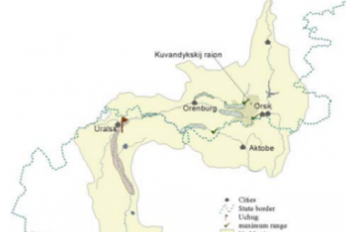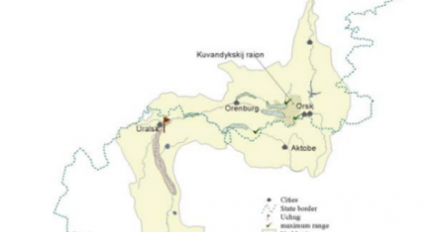Documents
This section features public documents and files uploaded by the stakeholders and custodians of the Caspian Sea environment.
 Akzhaiyk Reserve General InformationSat, 21/04/2018 - 11:16State Nature Reserve "Akzhaiyk" (Kazakh "Aқzhayyқ" memlekettіk tabiғi reserves) is located in the Makhambet Atyrau region, in the surrounding lands outside the city of Atyrau. It was created by the Government of the Republic of Kazakhstan on February 6, 2009 in the delta of the Ural River and the adjacent coast of the Caspia
Akzhaiyk Reserve General InformationSat, 21/04/2018 - 11:16State Nature Reserve "Akzhaiyk" (Kazakh "Aқzhayyқ" memlekettіk tabiғi reserves) is located in the Makhambet Atyrau region, in the surrounding lands outside the city of Atyrau. It was created by the Government of the Republic of Kazakhstan on February 6, 2009 in the delta of the Ural River and the adjacent coast of the Caspia
- Description
State Nature Reserve "Akzhaiyk" (Kazakh "Aқzhayyқ" memlekettіk tabiғi reserves) is located in the Makhambet Atyrau region, in the surrounding lands outside the city of Atyrau. It was created by the Government of the Republic of Kazakhstan on February 6, 2009 in the delta of the Ural River and the adjacent coast of the Caspian Sea. [1] The Ural River Delta and the adjacent coast of the Caspian Sea is included in the list of wetlands of international importance. The reserve was the second Kazakh territory after the Tengiz-Korgalzhyn lake system, which went down in the list. The hydrological regime is characterized by a gradual rise the water level in the Ural River in the second half of April, with the transition in May-June in spring and summer, with a peak at the end of May or the first half of of June. After the first flood peak starts fast and then gradual decline, passing in August and September in the autumn low water.
- Attached documents
- Metadata
- Year
- 2012
 The Ural River Sturgeons: Population Dynamics, Catch, Reasons for Decline and Restoration StrategiesSat, 21/04/2018 - 11:06The Ural sturgeon yield-to-fishery relative to river discharge was the highest in the Caspian Sea till recently. The environmental conditions to secure natural reproduction are still satisfactory for successful sturgeon reproduction. However, nowadays the catch in all regional sturgeon species is negligible. The Ural sturgeo
The Ural River Sturgeons: Population Dynamics, Catch, Reasons for Decline and Restoration StrategiesSat, 21/04/2018 - 11:06The Ural sturgeon yield-to-fishery relative to river discharge was the highest in the Caspian Sea till recently. The environmental conditions to secure natural reproduction are still satisfactory for successful sturgeon reproduction. However, nowadays the catch in all regional sturgeon species is negligible. The Ural sturgeo
- Description
The Ural sturgeon yield-to-fishery relative to river discharge was the highest in the Caspian Sea till recently. The environmental conditions to secure natural reproduction are still satisfactory for successful sturgeon reproduction. However, nowadays the catch in all regional sturgeon species is negligible. The Ural sturgeon population dynamics are analyzed along with some anthropogenic and natural factors affecting them. It is argued that legal overfishing (including all legal means of fish removal), based upon (a) faulty estimations of sturgeon stock and catch limits and (b) inappropriate fishery policies are the principal reasons for the stock decline in the Ural. The maintenance of the natural reproduction in the Ural is considered to be the primary strategy for the stock replenishment. If used at all, artificial propagation should be used only as an additional secondary option exclusively at the historical sturgeon habitats upstream the Ural river and not in the river delta, where the hatcheries are located now. Transboundary cooperation of basin countries with active inter- national involvement is essential to prevent further deterioration of the situation. ***The attached copy is furnished to the author for non-commercial research and education use, including for instruction at the author’s institution, sharing with colleagues and providing to institution administration. Other uses, including reproduction and distribution, or selling or licensing copies, or posting to personal, institutional or third party websites are prohibited. In most cases authors are permitted to post their version of the chapter (e.g. in Word or TEX form) to their personal website or institutional repository.***
- Attached documents
- Metadata
- Year
- 2008
Document

Akzhaiyk Reserve General Information
Document

